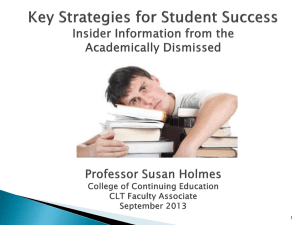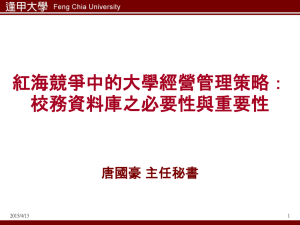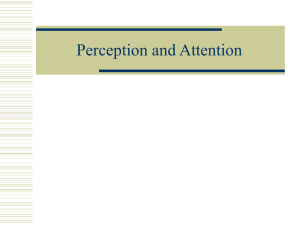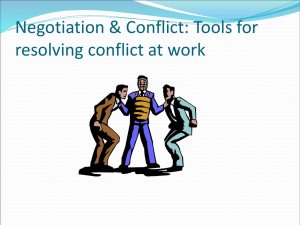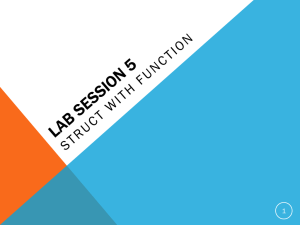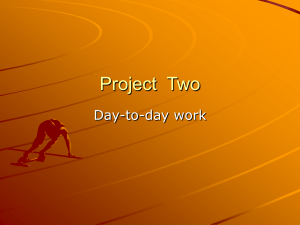PowerPoint Day 2 - Utah Education Network
advertisement
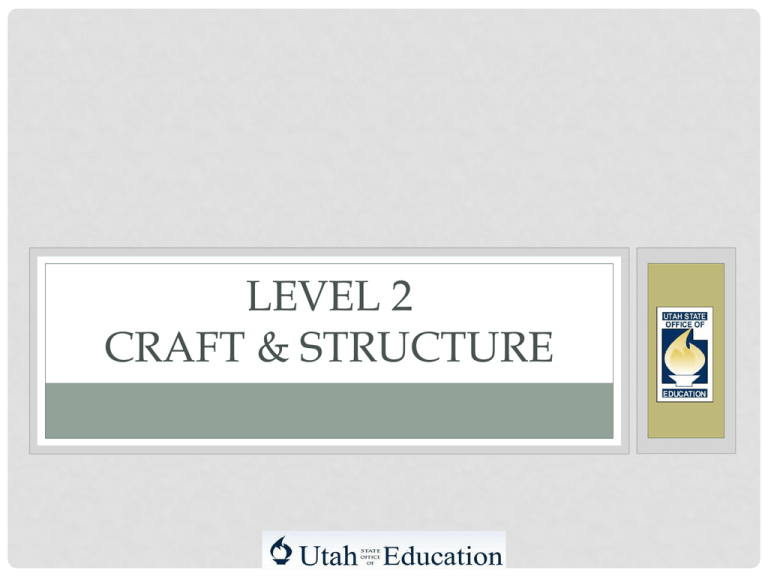
LEVEL 2 CRAFT & STRUCTURE As you enter today, please hang your Level 1 questions under the “Level 1” sign in the hall. HEARTS AND WISHES • 3 Hearts are things you will take back, or that you found helpful. • A Wish is something you need more information on or we did not cover. Something you WISH you knew more about from today (please don’t comment on things like temperature etc.). REVIEW LEVEL 1 • Gallery walk of Level 1 Each Kindness Questions • Questions? • Thoughts? TEA PARTY 1. Read your piece of the text from the Close Reading Article from yeterday. 2. Find three people you don’t know and discuss what the text means to you and listen to their ideas as well. TEXT COMPLEXITY • WHERE IS THIS IN THE UTAH CORE? Appendix A - pages 3-17 EXPERT STRATEGY • You will be assigned a number. • All the ones will be together at one spot in the room, twos, threes (etc). • Read your assigned section of your article in Appendix A about Text Complexity. • Discuss this section with your group, make notes, you will be the expert and teach others about this section. • After about 5 minutes you will then mix. There will be one of each number at a table. Each expert will teach the others in the group about their section. • We will then share out as a group about what we have learned. THIS IS HOW I FEEL WHEN I TEACH TEXT COMPLEXITY. . . . • http://www.youtube.com/watch?v=KdxEAt91D7k THE CRISIS • Complexity of texts ≠ college and career readiness: • High school textbooks have declined in all subject areas over several decades • Average length of sentences in K-8 textbooks has declined from 20 to 14 words • Vocabulary demands have declined, e.g., 8th grade textbooks = former 5th grade texts; 12th grade anthologies = former 7th grade texts • Complexity of college and careers texts has remained steady or increased, resulting in a huge gap (350L+) LEXILE CREATING A LEXILE LEVEL • 125 word slice • Sentence length • Difficulty of vocabulary • http://www.youtube.com/watch?v=fr0jQzrDafw Grade Band Old Lexile Ranges K-1 100-500 100-500 2-3 450-725 450-790 4-5 645-845 770-980 6-8 860-1010 955-1155 9-10 960-1115 1080-1305 11-12 1070-1220 1215-1355 LEXILE RANGES AND New Aligned GRADE BANDS Ranges Caveat: Not valid for drama or poetry…it’s an algorithm, and therefore, fallible. Definition of text complexity 1. Quantitative measures – readability and other scores of text complexity often best measured by a computer. 2. Qualitative measures – levels of meaning, structure, language conventionality and clarity, and knowledge demands often best measured by an attentive human. 3. Reader and Task considerations – background knowledge of reader, motivation, interests, and complexity generated by tasks assigned often best made by educators employing their professional judgment. Reader and Task QUANTITATIVE Text Complexity Grade Bands Suggested Lexile Range K-1 100L – 500L* 2-3 450L – 790L 4-5 770L – 980L 6-8 955L – 1155L 9-10 1080L – 1305L 11-CCR 1215L – 1355L Lexile Analyzer www.lexile.com/findabook/ WARNING! 1000L Lexile Measure 224 Pages Fiction & ... Humor & ... Juvenile Categories QUALITATIVE The rubric for literature and the rubric for informational text allow educators to evaluate the important elements of text that are often missed by computer software that tend to focus on more easily measured factors. The educator is critical here. • Levels of Purpose What will the reader gain from reading this text? • Structure How is the text designed to support the reader in accessing the purpose? • Language Conventionality and Clarity How does language effect accessibility? • Knowledge Demands What does the student need to know to access the text? LEVELS OF MEANING OR PURPOSE: The Sun Also Rises by Ernest Hemingway Quantitative Measurement Lexile: 610L Qualitative Measurement: Hemingway uses images and word choice to convey emotions rather than describing it; the words often have multiple connotative meanings; the story contains multiple complex and mature themes. Adjusted text complexity value: 11.5+ STRUCTURE: *Holes, by Louis Sachar Quantitative Measurement: 660L Qualitative Measurement: Structure: Story continuously jumps back and forth between three different time periods, settings, and character groups. Adjusted text complexity value: 5.9 – 7.5 f KNOWLEDGE DEMANDS The Grapes of Wrath by John Steinbeck Quantitative Measurement: 680L Qualitative Measurement: Sophisticated themes. The experiences and perspective conveyed will likely be different from many of our students. Knowledge of the Great Depression, the “Okie Migration” to California, and the religion and music of the migrants would be helpful. Adjusted text complexity value: 9-10 READER AND TASKS The questions provided in this resource are meant to spur teacher thought and reflection upon the text, students, and any tasks associated with the text. Thinking Skills Reading Skills Motivation and Engagement Prior Knowledge and Experience Content or Theme Concerns THE PROCESS 1. Determine the quantitative measures of the text. 2. Analyze the qualitative measures of the text. 3. Reflect upon the reader and task considerations. 4. Recommend placement in the appropriate text complexity band. Reader and Task TEXT COMPLEXITY RUBRIC RUBRIC ACTIVITY USING “THE OTHER SIDE” , THE LEXILE ANALYZER ALONG WITH...”THE AMAZING TOOL” www.lexile.com/findabook/ IMPORTANT DISCOVERIES • The text complexity analysis process gives us a method for becoming more purposeful in text selection. • The process helps us at all grade levels to be confident in our content knowledge and ability to read and analyze a text before we teach it. • The process encourages us to engage in meaningful discussions about text with colleagues. IN THE END… “The use of qualitative and quantitative measures to assess text complexity is balanced in the Standards’ model by the expectation that educators will employ professional judgment to match texts to particular students and tasks.” Appendix A DO YOU GET IT NOW? LOOKING AT LEVEL 2 CRAFT & STRUCTURE AS TEACHERS DO WE FEEL LIKE THIS WHEN WE ARE TOLD WE HAVE ANOTHER THING TO TEACH? TEXT FEATURES WHERE IS THIS IN THE UTAH CORE? Page 15 - RI2.5 Page 16 - RI3.5 We can teach language arts in collaboration with other subjects. TEXT FEATURES are one of those skills easily taught during other subjects. WHY ARE TEXT FEATURES IMPORTANT? • Text Features help us to identify the big ideas and topics that the author is focusing on. • Authors use text features to bring attention to important details. • Visual text features such as maps and charts help to support the information the author presents in the text. • Text features make the text more accessible to the reader and often provide additional information to help students comprehend the content. INFORMATIONAL TEXT LEVEL 2 CRAFT & STRUCTURE LEVEL 2 TEXT FEATURES TEXT-DEPENDENT QUESTIONS Paula the Predictor What key facts do the text features of the text help us to understand? USOE EARTH & MOON BOOK This book was created by Davis School District using the text from UEN http://www.uen.org/core/science/scibe r/TRB3/index.shtml Teacher plan ahead copy Student copy TEXT FEATURES CONTINUED Work in partners to do a review game with worksheet. • Number different text features • Teacher defines a text feature • Partners: • A. Think (think of the answer) • B. Share (show the numbered answer on their fingers) • C. Show (teams show the class the answers they came up with) TEXT STRUCTURE WHERE IS THIS IN THE UTAH CORE? Pg 13 – RL2.3 & 2.5, Pg 14 – RL3.3 & 3.5 Pg 15 – RI2.3, Pg 16 – RI3.3 This is also a part of the overall strand Craft and Structure. VALUE OF TEACHING TEXT STRUCTURE When we use and teach the same text structures repeatedly, students can “save the template in their brain,” so it can be recalled later, or students can organize ideas on their own. Ray Reutzel, DSD training 12/9/10 TEXT STRUCTURE CONTINUED “If students are reading to answer their own questions (they do this while filling in a graphic organizer), their comprehension increases by 50%.” Ray Reutzel, DSD training, 12-9-10 INFORMATIONAL TEXT STRUCTURES A DAPTED FROM A POWER POINT PRESENTATION CREA TED BY BEV NETTO Narrative (Literature) • Prevalent in oral stories, novels, movies, drama • Based on familiar world knowledge • Follows a structure more aligned with oral language Expository (Informational Text) • Prevalent in magazines, manuals, encyclopedias, poetry, newspapers, etc. • Unfamiliar or abstract content • Uses many organizational structures ORGANIZATIONAL PATTERNS “Read” the texts below. • Which is a narrative (literature)? • Which is expository (informational text)? • How can you tell? XXXXXXX xx XXXXXX I. Xxxxx Initially, xxxx xxxxxx xxxxxx xxxx xxxx xxx xxxx xxxxxxx xxx xx xxxx. Xxxxx xx xxxx xxxx xxxxx xxxxxx xxx. Xxxx, xxxxx, xxxx xxxxxx. II. Xxxx Xxxxx Xxxx, xxxx, xxx, xx: • Xxxx • Xxxxxxx xxx XXXXXXX xx XXXXXX As she lingered xxx xxxx xxxxxx xxxxx xxxx xxxxxx. Xxxx, xxxxx xxxx xxxx! Xxxx xxxx xxxx. Xxxx! Xxxx! Xxxxxxx xxxx xxxx, xxxx xxxx xxxxx xxxx xxxx. Xxxx xxxx, “Xxxxxx xxxxx. Xxxx xxxx xxxxxxx xxx xx xxxxxxx xxxx?” Cochran and Hain, WHAT IS TEXT STRUCTURE? Text structure refers to the organization of ideas in a text. As authors write a text to communicate an idea, they will use a structure that goes along with the idea (Meyer 1985). Literature Text Structure Informational Text Structures • Narrative or Story Structure • Time Order Sequence • Description • Listing • Compare and Contrast • Cause – Effect • Problem and Solution Reutzel, Cooter (2008) NARRATIVE STORY STRUCTURE Beginning Middle End NARRATIVE STORY STRUCTURE Story Setting Map Problem Goal Events Resolution (Reutzel, 1985) Readers who know how an informational text is organized have a better idea of how to read and understand its content. For example, when they know a text has a cause and effect structure, they can focus on finding the cause(s) and result(s) that the text is highlighting. Once they know what to focus on while they are reading, they get a clear frame of the text, which helps them better comprehend content. INFORMATIONAL TEXTS HAVE CLEAR TEXT STRUCTURES: • Time order organizes information into a chronological sequence. • Description explains an idea or concept. • Listing /classification arranges a group of facts, concepts, or events. • Compare and contrast analyzes similarities and differences among concepts and events. • Cause and effect presents how an event or fact brings about another event or result. • Problem and solution presents a problem with Reutzel & Cooter (2007) a solution. Time Order/ Sequence This structure is organized from one point in time to another. It’s also the most similar to narrative. • Sequence text structures are the easiest for younger students. • Books to teach this structure include counting books, days of the week, months of the year, seasons, life cycles, directions, and some question and answer books. Reutzel & Cooter (2008) SEQUENCE TEXT STRUCTURE FRAME Here is how a ________________________ is made. First, ________________________. Next, ______________________. Then, ______________________. Finally, ______________________. LISTING/ CLASSIFICATION • Lists ideas on a specific topic (dogs, frog, evaporation) one after the other. • States main topic in the topic sentence and has a list of examples for support. LISTING / CLASSIFICATION TEXT STRUCTURE FRAME ______________________ is the title of the selection. Three categories or classifications are part of this topic. The first classification is _____________________________. Some examples are _____________________________. The second classification is _____________________________. In particular, _____________________________. The third classification is _____________________________. Specifically, _____________________________. These categories are related _____________________________. Description This text structure: • Describes the attributes and features of people, places, or items • Describes one topic DESCRIPTIVE TEXT STRUCTURE FRAME There are ___________ kinds of _______________. The first kind of ____________________________ is _________________________. It ________________. The second one is ________________________. It ________________________________________________ _______________________________________. The third kind is ___________________________. It __________________________________________. Now you can recognize the ___________________ kinds of ___________________________. Compare and Contrast • Shows how two or more ideas or items are similar or different. • May use a clustered approach, with details about one topic followed by details about the other topic. • May show an alternating approach, with the author going between the two topics. • Is fairly easy for students to understand. GOOSE BUMPS Text Structures and the Revolutionary War Directions: Read the passages and on a sheet of paper, put the information from each passage into an appropriate graphic organizer. The following graphic organizers are examples. Feel free to make changes if necessary. Chronological Sequence Cause and Effect Problem and Solution Compare and Contrast 1. Divisions The Revolutionary War was a time of great division. Americans were split into two groups: Patriots and Loyalists. Patriots were Americans who supported the struggle for independence. They believed that Americans should be free from the control of an English king. They fought against the English to establish a new government in America. Loyalists were Americans who remained loyal to the crown. Some of them were happy under English rule. Others believed that they might be rewarded after the Americans lost the war. Though both Patriots and Loyalists lived in America, a deep division ran between them. 2. The Turning Point Though the Americans suffered many losses early on in the war, the momentum began to shift after the Battles of Saratoga. During the Battles of Saratoga, the Americans captured British General Burgoyne’s army. This victory convinced other countries, especially France, that the Americans could win the war. Because of this, not only did France declare war on England, but other nations also began openly supporting the American fight for independence. The Battles of Saratoga will be remembered as a pivotal moment in this fight. 3. Guerilla Warfare In most cases American soldiers could not stand toe-to-toe against British soldiers. The British were better trained, better armed, and more experienced. When the American soldiers attempted to match the British, they suffered heavy losses. The Americans had to use what advantages they had, so they developed what are now known as Guerilla Warfare tactics. Guerrilla warfare is a form of fighting where small groups of fighters use ambushes, sabotages, and the elements of surprise to harass a larger, less mobile army. By using Guerilla Warfare tactics, American soldiers were able to equalize some of the British’s advantages on the battlefield. 4. Fire Cake American soldiers during the Revolutionary War suffered horrible conditions to win independence. You can experience some of these conditions by eating the same food that soldiers ate at Valley Forge: fire cake. Fire cake is a horrible tasting blob of burnt gluten. To make some first mix flour with water until you get thick, damp dough. Then, form it into a cake and in your palms. Put this doughy lump on a greased cookie sheet and bake it until it is brown. This will be very similar to the awful fire cakes that American soldiers ate at Valley Forge. Enjoy! 5. Allies During the Revolutionary War, Americans learned just how important friends can be. When the Americans declared independence on July 4th, 1776, they had virtually no allies. But on February 6th, 1778, after the American victory at Saratoga, the French assisted the American cause. The French went into deep debt helping the Americans. The Americans would receive additional help in June of 1779, when the Spanish joined the fight against the British. They would secure Southern ports and supply lines. Without the help of these allies, many more Americans would have died in the fight for independence. TEXT STRUCTURE GAME • Divide into 5 groups • Each group gets a colored stack of graphic organizers to sort LET’S PRACTICE TEXT STRUCTURES INFORMATIONAL TEXT LEVEL 2 VOCABULARY WHERE IS THIS IN THE UTAH CORE? All about meaning of words: Page 13 - RL2.4; Page 15 – RI2.4 Page 14 - RL3.4; Page 16 - RI3.4 DYNAMIC VOCABULARY INSTRUCTION ANITA L ARCHER, PHD EXPLICIT INSTRUCTION: EFFECTIVE AND EFFICIENT TEACHING IMPORTANCE OF VOCABULARY INSTRUCTION Children’s vocabulary in the early grades relates to reading comprehension in the upper grades. Preschool - Children’s vocabulary correlated with reading comprehension in upper elementary school. (Dickinson & Tabois, 2001) Kindergarten - Vocabulary size was an effective predictor of reading comprehension in middle elementary years. (Scarborough, 1998) First Grade - Orally tested vocabulary was a significant predictor of reading comprehension ten years later. (Cunningham & Stanovich, 1997) Third Grade - Children with restricted vocabulary have declining comprehension scores in the later elementary years. (Chall, Jacobs, & Baldwin, 1990) EXPLICIT VOCABULARY INSTRUCTION Evidence suggests that as late as Grade 6, about 80% of words are learned as a result of direct explanation, either as a result of the child’s request or instruction, usually by a teacher. (Biemiller, 1999, 2005) IMPORTANCE OF VOCABULARY INSTRUCTION - CONCLUSION To close the vocabulary gap, vocabulary acquisition must be accelerated through intentional instruction. Vocabulary instruction must be a focus in all classes in all grades. COMPONENTS OF A VOCABULARY PROGRAM High-quality Classroom Language (Dickinson, Cote, & Smith, 1993) Reading Aloud to Students (Elley, 1989; Senechal, 1997) Explicit Vocabulary Instruction (Baker, Kame’enui, & Simmons, 1998; Baumann, Kame’enui, & Ash, 2003; Beck & McKeown, 1991; Beck, McKeown, & Kucan, 2002; Biemiller, 2004; Marzano, 2004; Paribakht & Wesche, 1997) Word-Learning Strategies (Buikima & Graves, 1993; Edwards, Font, Baumann, & Boland, 2004; Graves, 2004; White, Sowell, & Yanagihara, 1989) Wide Independent Reading (Anderson & Nagy, 1992; Cunningham & Stanovich, 1998; Nagy, Anderson, & Herman, 1987; Sternberg, 1987) USE HIGH QUALITY LANGUAGE Use high quality vocabulary in the classroom. To ensure understanding provide a little explanation of the unknown word’s meaning. Directly tell students the meaning of the word. “Don’t procrastinate on your assignment. Procrastinate means to put off doing something.” Pair the unknown word with a synonym. “Laws have their genesis -- their beginning -- in EXPLICIT VOCABULARY INSTRUCTION – SELECTION OF VOCABULARY Select a limited number of words for robust, explicit vocabulary instruction. Three to ten words per story or section in a chapter would be appropriate. Briefly tell students the meaning of other words that are needed for comprehension. EXPLICIT VOCABULARY INSTRUCTION – SELECTION OF VOCABULARY (BECK & MCKEOWN, 1985) Tier One - Basic words chair, bed, happy, house Tier Two - Words in general use in many domains (Academic Vocabulary) concentrate, absurd, fortunate, relieved, dignity, convenient, observation, analyze, persistence (Academic vocabulary) Tier Three - Rare words limited to a specific domain (Background Knowledge) tundra, igneous rocks, constitution, area, sacrifice fly, genre, foreshadowing EXPLICIT VOCABULARY INSTRUCTION – PREPARE STUDENT-FRIENDLY EXPLANATIONS Dictionary Definition relieved - (1) To free wholly or partly from pain, stress, pressure. (2) To lessen or alleviate, as pain or pressure Student-Friendly Explanation (Beck, McKeown, & Kucan, 2003) Is easy to understand. When something that was difficult is over or never happened at all, you feel relieved. TEACH THE MEANING OF CRITICAL, UNKNOWN VOCABULARY WORDS. INSTRUCTIONAL ROUTINE (Note: Teach words AFTER you have read a story to your students and BEFORE students read a selection.) Step 1. Introduce the word. Write the word on the board or document camera. Read the word and have the students repeat the word. If the word is difficult to pronounce or unfamiliar have the students repeat the word a number of times. Introduce the word with me. “ This word is relieved. What word?” TEACH THE MEANING OF CRITICAL, UNKNOWN VOCABULARY WORDS. INSTRUCTIONAL ROUTINE Step 2. Present a student-friendly explanation. Tell students the explanation. OR Have them read the explanation with you. Present the definition with me. “When something that is difficult is over or never happened at all, you feel relieved. So if something that is difficult is over, you would feel _______________.” TEACH THE MEANING OF CRITICAL, UNKNOWN VOCABULARY WORDS. INSTRUCTIONAL ROUTINE Step 3. Illustrate the word with examples. Concrete examples. Visual representations. Verbal examples. Present the examples with me. “When the spelling test is over, you feel relieved.” “When you have finished giving the speech that you dreaded, you feel relieved.” TEACH THE MEANING OF CRITICAL, UNKNOWN VOCABULARY WORDS. INSTRUCTIONAL ROUTINE Step 4. Check students’ understanding. Option #1. Ask deep processing questions. Check students’ understanding with me. When the students lined up for morning recess, Jason said, “I am so relieved that this morning is over.” Why might Jason be relieved? When Maria was told that the soccer game had been cancelled, she said, “I am relieved.” Why might Maria be relieved? TEACH THE MEANING OF CRITICAL, UNKNOWN VOCABULARY WORDS. INSTRUCTIONAL ROUTINE Step 4. Check students’ understanding. Option #2. Have students discern between examples and non-examples. Check students’ understanding with me. “If you were nervous singing in front of others, would you feel relieved when the concert was over?” Yes “Why?” “If you loved singing to audiences, would you feel relieved when the concert was over?” No “Why not?” It was not difficult for you. TEACH THE MEANING OF CRITICAL, UNKNOWN VOCABULARY WORDS. INSTRUCTIONAL ROUTINE Step 4. Check students’ understanding. Option #3. Have students generate their own examples. Check students’ understanding with me. “Tell your partner about a time when you were relieved.” TEACH THE MEANING OF CRITICAL, UNKNOWN VOCABULARY WORDS. INSTRUCTIONAL ROUTINE Step 4. Check students’ understanding. Option #4. Provide students with a “sentence starter”. Have them say the complete sentence. Check students’ understanding with me. Sometimes your mother is relieved. Tell your partner when your mother is relieved. Start your sentence by saying, “My mother is relieved when________.” TRANSFER THE WORD INTO EVERYDAY USE • Graduated Word: orbit • How many times did you use “orbit” this week in your speaking, reading, and writing? Orbit OTHER WAYS TO DEVELOP CONCEPTUAL UNDERSTANDING Act it out: • Girls orbit around a new boy at school. INFORMATIONAL TEXT VOCABULARY LEVEL 2 CRAFT & STRUCTURE WHERE IS THIS IN THE UTAH CORE? All about meaning of words: Page 13 - RL2.4; Page 15 – RI2.4 Page 14 - RL3.4; Page 16 - RI3.4 LEVEL 2 TEXT-DEPENDENT QUESTION VOCABULARY • What context clues on page 2 of the “Earth & Moon” booklet help us to understand what the word appearance means? ACADEMIC VOCABULARY FROM THE CORE • When talking about vocabulary, we must remember to use the vocabulary and language from the core with our students. Key Ideas & Details Text Structure Evidence Support Events INFORMATIONAL TEXT VOCABULARY LEVEL 2 CRAFT & STRUCTURE LEVEL 2 TEXT-DEPENDENT QUESTION VOCABULARY • What context clues on page 2 of the “Earth & Moon” booklet help us to understand what the word appearance means? ACADEMIC VOCABULARY FROM THE CORE • When talking about vocabulary, we must remember to use the vocabulary and language from the core with our students. Key Ideas & Details Text Structure Evidence Support Events LITERATURE LEVEL 2 CRAFT & STRUCTURE WHERE IS THIS IN THE UTAH CORE? Page 13 - RL2.6 Page 14 – RL3.4 and RL3.6 LITERATURE LEVEL 2 CRAFT & STRUCTURE WRITING LEVEL 2 QUESTIONS Vocabulary and Text Structure question stem examples: What is the literal meaning of ___________________? What is the figurative meaning of __________________? How does the sequence of events/order of claims develop the piece? Author’s Purpose question stem examples: Why did the author write this? What do we know about the narrator? Who’s story is not represented? CREATE LEVEL 2 QUESTIONS FROM THIS SELECTION CREATE YOUR OWN LEVEL 2 QUESTION CONNECTING THE ARTS WHERE IS THIS IN THE UTAH CORE? Page 25 - S&L2.1 Page 26 - S&L3.1 CONNECTING THE ARTS • Art enhances learning, social, and emotional development. • Art is connected to self-confidence, persistence, concentration, comprehension, conflict resolution, motivation, cognitive engagement, risk-taking, perseverance, and leadership. • Several studies show that children become more engaged in their studies when the arts are integrated into their lessons. • Others show that at-risk students often find pathways through the arts to broader academic successes. • http://www.giarts.org/article/connections-between-education-arts-and-student-achievement INCORPORATING ART • • • • • • • • Open ended drawings Collages Paintings Poetry Drama Music Story telling Sculpting INTEGRATING ART INTO THE CLASSROOM • Art is an outstanding tool for teaching not only developmental skills, but also academic subjects such as math, science, and literacy. • The most effective learning takes place when children do something related to the topic they are learning. • This information has been recognized by teachers since the time of Confucius, when he said: "I hear and I forget. I see and I remember; I do and I understand.“ • Art Influences Learning By Anna Reyner Early Childhood News ART & LITERACY • Children who draw pictures of stories they have read improve their reading comprehension, and are motivated to read new material (Deasy & Stevenson, 2002). • Art Influences Learning By Anna Reyner Early Childhood News STEPPING INTO THE PAINTING • This visual arts strategy involves carefully inspecting a chosen painting as a way to interpret personal meaning for each student. • Students then combine their interpretations to create a global story from the painting. NORMAN ROCKWELL PHOTO INSPIRATION HOMEWORK • Read Text Complexity article “7 Actions that Teachers Can Take Right Now: Text Complexity” by Elfrieda H. Hiebert • Answer the Level 1 and Level 2 questions • Level 1 question: What does the author claim teachers can do to support students using complex text? • Level 2 question: How would you rank the seven actions teachers can take? Cite evidence to support your decisions. HEARTS AND WISHES • 3 Hearts are things you will take back, or that you found helpful. • A Wish is something you need more information on or we did not cover. Something you WISH you knew more about from today (please don’t comment on things like temperature etc.).
